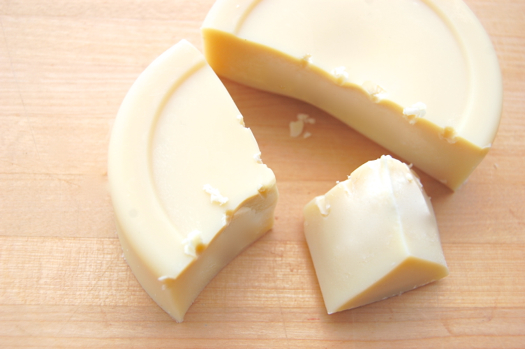Cocoa Butter

Cocoa butter is a very unusual fat. Granted, in its refined form it doesn’t look like much. It’s white, flavorless, odorless and soap-like in its firmness. However it doesn’t take too much fiddling with it to understand how unique it is. First there’s the low melt point. Cocoa butter is comprised of 21 different fats, all of which melt between 55 and 114 degrees Fahrenheit. The average melting temperature of those fats is 87 degrees Fahrenheit. Which means that cocoa butter melts easily in the mouth — even on the skin, which is why cocoa butter is in such high demand in the cosmetic industry.
But what really distinguishes cocoa butter is the speed at which it melts. Cocoa butter has what’s called a “sharp” melting point, meaning that when it gets much above that magic temperature of 87 degrees it goes liquid rapidly. The reason is because, while cocoa butter has 21 different fats in it, just three of those fats make up nearly half of its bulk, and they all melt at around the same temperature: between 87 and 91 depending on whether the cocoa butter has been tempered or not. That means that when cocoa butter hits the warm environment of your mouth it almost instantly transforms into a liquid. However, because there are fats in the mix that melt at higher temperature (up to 114) that liquid isn’t especially thin. That high viscosity is a good thing from the standpoint of someone who likes to eat, for if the cocoa butter happens to be mixed with any nice flavor-giving compounds (chocolate solids anyone?), those compounds hang around on the tongue and on the surfaces of the mouth for a while, bathing the taste buds in flavor.
Very interesting, no? The only problem with cocoa butter is its price, which is a result of competition between the confectionery and cosmetics industries. Let’s say, for example, that a pound of chocolate liquor goes for $3.00. If you were to refine that chocolate liquor and separate the cocoa solids and cocoa butter, the solids would sell for about $1.20. The refined cocoa butter, however, would sell for $6.00. So there’s that. Another down side is the fact that cocoa butter is very rigid when it’s cool, and that’s not always a good thing. Indeed cocoa butter gets tooth-shatteringly hard when it gets below 55 degrees Fahrenheit, which means it’s not so good in ice cream. That’s why ice cream makers generally use a cocoa butter equivalent (CBE) for chocolate that goes into frozen treats.
Hi Joe! I know there are special cocoa butter products made specifically for tempering, but this chef posted that normal cocoa butter could be grated for the same purpose: http://www.chefeddy.com/2010/03/temper-or-pre-crystallize-chocolate-using-cocoa-butter/. I tried to ask him whether raw cocoa butter could be used as well, but he never got back to me. Would love to know if you have any idea whether it might work? TIA!
What he’s doing there is seeding the melted chocolate with shaved cocoa butter to get the crystal structure he wants. That’s ingenious! The question is whether raw cocoa butter producers temper their product before they ship it, and honestly I have no idea. You’d have to ask the manufacturer…though my guess is that any cocoa butter you’d find in a candy supply shop would be tempered. If you find it in a health food store (where people use it more as a skin moisturizer) then maybe not. Thanks for the link, Xiaolu!
– Joe